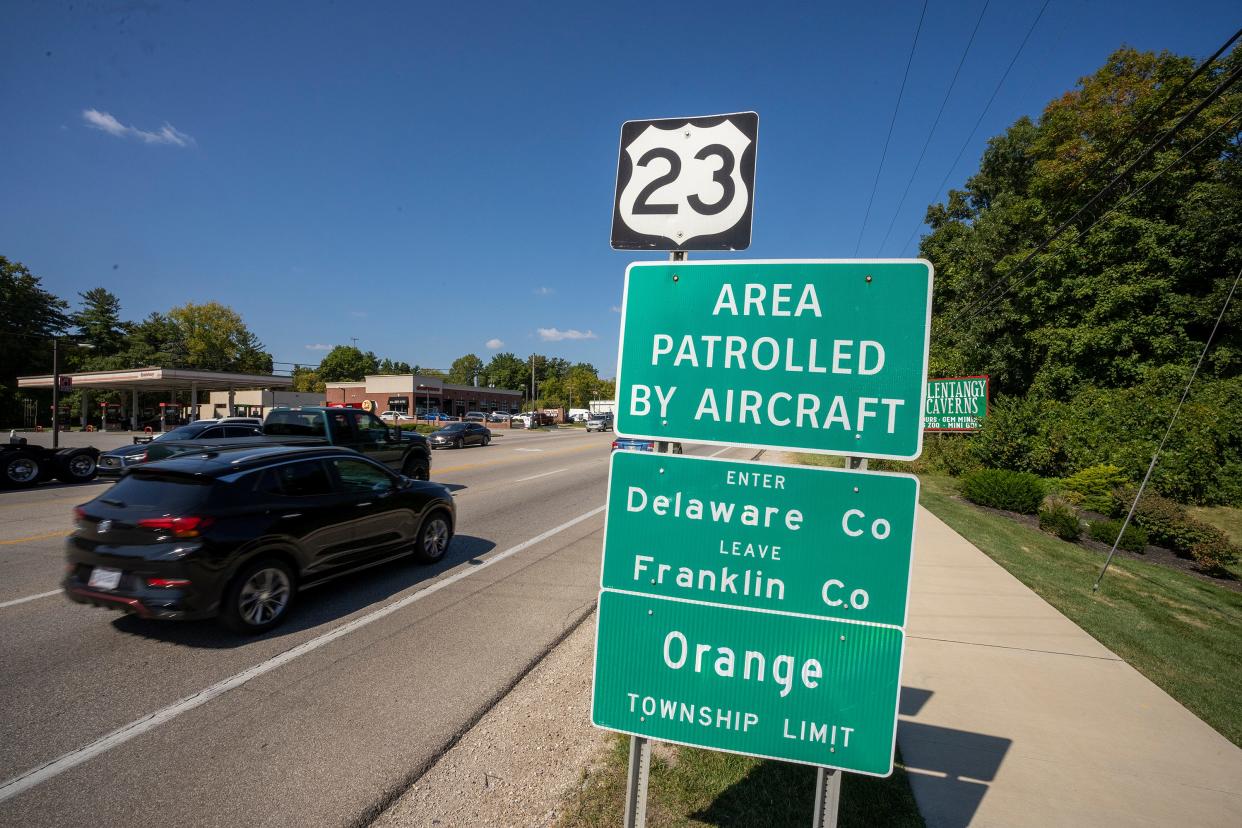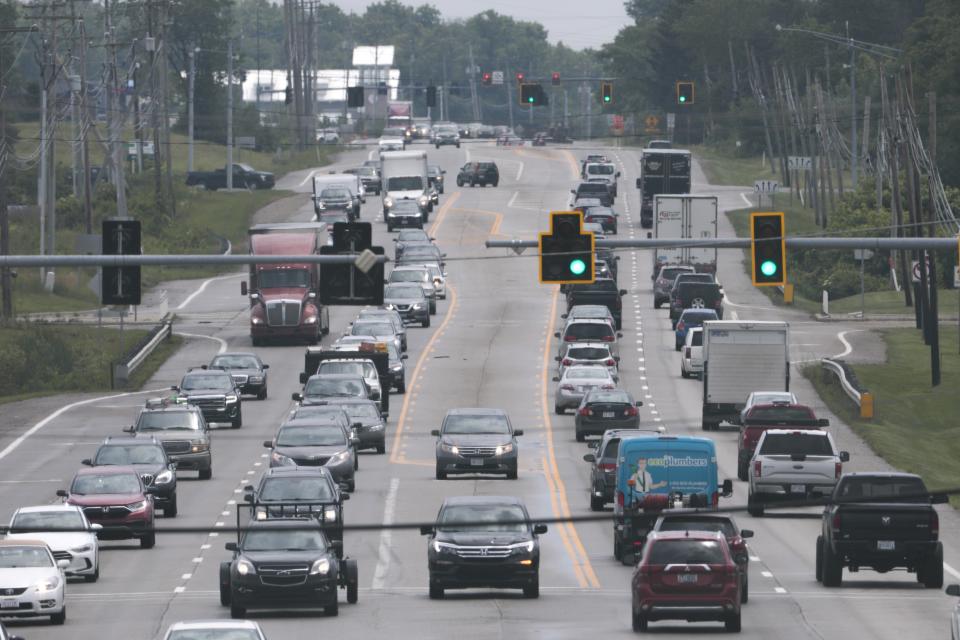DeWine: U.S. 23 congestion 'unacceptable' in Delaware County, Ohio to seek solutions

- Oops!Something went wrong.Please try again later.
The numbers are easy: 23 miles of U.S. 23 through Delaware County, between Worthington and Waldo in Marion County.
But traversing the stretch of state highway can be arduous, and too often dangerous. With 40 traffic signals and 30% more traffic than the roadway was designed for, motorists experience congestion, uncertain travel times, bottlenecks and high crash rates.
That's why the Ohio Department of Transportation (ODOT) is focusing its attention on the corridor with the goal of improving safety and efficiency along the connector in the state's fastest-growing county.
Gov. Mike DeWine calls the traffic situation along U.S. 23 "unacceptable" In a prepared statement, the governor said "the sheer number of stops and traffic signals has grown over time and reduced the free flow of travel."
More: ODOT nixes changes to U.S. 23 in Delaware County after reviewing public feedback, cost
Since 1997, ODOT Director Jack Marchbanks has witnessed the intense growth in the area, fueled by Polaris Fashion Place, nearby JPMorgan Chase offices with about 12,000 employees, and thousands of new homes in southern Delaware County.
"I have the benefit, or pain, of seeing this corridor become congested," Marchbanks said.
Four types of upgrades
The state's plans for dealing with U.S. 23 includes several options that focus on safety, said Toni Turowski, ODOT's District 6 deputy director and a traffic engineer. Throughout this and next year, there will be meetings with community and business leaders and the public. Final plans should be decided by the end of 2024, officials say.

Potential upgrades include:
Traditional interchange: Typically used on freeways with high volume, these replace an intersection with a bridge and ramps, eliminating the need for traffic lights. ODOT has not said where one or more might be used.
Connector road interchanges: These are also useful in high-traffic areas, replacing an intersection with a bridge and two-way connector roads, eliminating the need for traffic signals. Unlike traditional interchanges, they minimize impact to adjacent property.
Restricted crossing U-turns: Dubbed "R-turns," these would restrict side street left turns onto U.S. 23. Instead they would direct traffic onto U.S. 23 via a right turn, followed by an immediate U-turn lane which could employ a traffic signal.
Overpasses and underpasses: Allow for nonstop traffic on and off U.S. 23, with use of traffic signals.
Those in the communities that U.S. 23 pass through are eager to learn more.
Joe Pemberton, chairman of OneDelaware, a development advocacy group in the county, said he cannot comment without seeing specific plans. But, he's eager to work with ODOT and others.
"The county has been very open to ODOT," Pemberton said. "The county is going to be open to partnerships and opportunities."
More: Route 23 in Delaware County has more traffic than it can handle, but what's the solution?
A study by DelawareNow and Delaware County and its finance authority five years ago envisioned the corridor as a destination for new business, a haven for commercial and residential growth, and a safer, faster byway with upgrades paid for through an improved tax base.
The Route 23 Corridor Study released in 2019, was intended to make it easier for businesses to locate here and improve the area's tax base. In 2015, Orange Township was being considered for an Amazon data center, which never happened. New Albany, instead, has become a juggernaut for Amazon with several data centers planned there.
How much will the changes cost?
Marchbanks said that a healthy state budget, along with federal infrastructure money, is allowing ODOT to move ahead with several projects to improve transit.
"The cost will depend on the menu of options that are ultimately selected," he said.
A new interchange can easily cost more than $10 million. The Route 665 interchange opened in 2012 at a cost of about $22 million, according to ODOT.
A proposed Big Walnut interchange for Interstate 71, discussed for years and also intended to move U.S. 23 traffic to I-71, is still being evaluated, but has no approved funding, said Turowski. Traffic counts are still being evaluated near Alum Creek Reservoir and east and west of the freeway.
What about pedestrians?
Marchbanks, an avid bicyclist, said the corridor, like any high traffic area, is not conducive to bike lanes, sidewalks or recreational paths. It instead has been, and will continue to be, designed for cars and trucks.
"It would be foolhardy to put a bike anywhere along Route 23, north of Lazelle," he said.
A continuing debate
Each workday, about about 50,000 commuters enter Delaware County on the way to their jobs, while about 65,000 leave the county for employment in Columbus and elsewhere.
Continued growth, including the burden on schools, will remain an issue. And not just around Delaware County.
“Northwest Ohio is home to industries like advanced manufacturing, automotive, energy, food processing, and logistics and distribution. From rail hubs to Lake Erie ports, billions of dollars-worth of goods flow through our part of the state,” ODOT District 2 Deputy Director Patrick McColley said in a prepared statement. “Tying these industries to central Ohio is key to our state’s economic prosperity.”
Statewide, it has been noted that more people want to visit Columbus from Toledo and Sandusky than those who want to leave Columbus to travel north.
ODOT officials maintain that further study and planning will be needed to enhance the corridor northward.
dnarciso@dispatch.com
This article originally appeared on The Columbus Dispatch: Ohio to prioritize reducing 'unacceptable' congestion on U.S. 23

